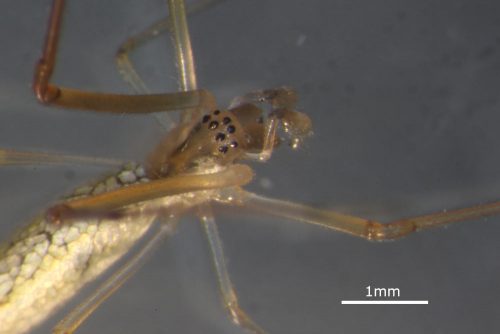A lot of e-ink has been spilled over the claim, primarily by Schweitzer, that intact, ancient soft tissue can be found inside fossilized dinosaur bones. She made some interesting observations of mysterious stuff extracted from fossils, but what it is and whether it’s actually preserved dinosaur tissue has been contentious. It’s baffled me, that’s for sure, since it didn’t jibe with my understanding of chemistry, and I couldn’t imagine some SF stasis field operating inside old bones. Here’s an excellent summary of the problem.
Reports of dinosaur protein and complex organic structure preservation are problematic for several reasons. Firstly, it remains unclear how such organics would be preserved for tens of millions of years. If endogenous, putative dinosaur soft tissues should contain diagenetically unstable proteins and phospholipids, vulnerable to hydrolysis, although the released fatty acid moieties from phospholipids could be stabilized through in situ polymerization into kerogen-like aliphatic structures. At 25°C and neutral pH, peptide bond half-lives from uncatalyzed hydrolysis are too short to allow for Mesozoic peptide preservation, although hydrolysis rates can be decreased through terminal modifications and steric effects on internal bonds. Estimates based on experimental gelatinization suggest that, even when frozen (0°C), relatively intact collagen has an upper age limit of only 2,700,000 years. Secondly, the instances of dinosaur peptide preservation reported are older than the oldest uncontested protein preservation reported by at least an order of magnitude. The oldest non-controversial peptides include partially intact peptides from 3.4 Ma in exceptionally cold environments, as well as short peptides bound to eggshell calcite crystals from 3.8 Ma stabilized via unique molecular preservation mechanisms. The youngest non-avian dinosaur bones are 66 million years old; on both theoretical and empirical grounds, it seems exceptional that original proteins could persist for so long.
Yeah, what he said. Complex molecules like proteins and nucleotides are going to degrade slowly over time, so what’s preventing breakdown in these fossils? Idea like polymerization or chemical modification into more stable molecules have been floating around, but it’s hard to get around the empirical fact that even a molecule as stable as collagen is going to fall apart, eventually.
These authors do an exhaustive analysis of the organic compounds found in ancient fossil bones, and most persuasively, do positive controls with recent bones and bones that are fossilized, but younger, and what they find is that the original organic material degrades steadily and somewhat predictably, and that dinosaur bones are destitute of original dinosaur soft tissue. They can find collagen in, for instance, shark teeth from the Pleistocene-Holocene, but it’s undetectable in older specimens.
So how to explain the spongy soft stuff found by some investigators inside dinosaur bones? Previous investigators failed to take into account the ubiquity of microbes.
Previous studies have often reported purported endogenous ‘soft tissues’ within fossil dinosaur bone. However, these studies often do not fully address fossil bones being open systems that are biologically active. This can be seen in field observations, in Dinosaur Provincial Park and elsewhere, where fossil bone is frequently colonized by lichen on the surface or overgrown and penetrated by plant roots in the subsurface. This forces researchers to consider that subsurface biota (e.g. plant roots, fungi, animals, protists, and bacteria) could contaminate bone. Given that fungi can produce collagen, the need to rule out exogenous sources of organics in fossil bone is made all the greater. Even deeply buried bone has the potential to be biologically active, given the high concentration of microorganisms in continental subsurface sedimentary rock. The analyses presented here are consistent with the idea that far from being biologically ‘dead’, fossil bone supports a diverse, active, and specialized microbial community. Given this, it is necessary to rule out the hypothesis of subsurface contamination before concluding that fossils preserve geochemically unstable endogenous organics, like proteins.
I find the idea that bacteria and fungi can successfully infiltrate rocks and bones far more likely than that bone chemistry can somehow suspend the laws of thermodynamics for a hundred million years. I’m going to tentatively accept the explanation of recent bacterial contamination for the soft tissue in fossil bone controversy.
The study of fossil organics must consider potential microbial presence throughout a specimen’s taphonomic history, from early to late. Microbial communities interact with fossils immediately following death and after burial, but prior to diagenesis. Microbes are known to utilize bone and tooth proteins and fossil evidence of early fungal colonization has even been detected. More recent microbial colonization of fossil bone will occur as it nears the surface during uplift and erosion in the late stages of the taphonomic process. Furthermore, given that microbes can inhabit the crust kilometres below the surface, it might be predicted that bone remains a biologically active habitat even when buried hundreds of meters deep for millions of years. The extensive potential for microbial contamination and metabolic consumption makes verifying claims of Mesozoic bone protein extremely challenging.
Remember, dino fans, “life will find a way”. Bacteria are amazing.
Also, it seems to me that Schweitzer et al. have discovered an interesting and possibly important phenomenon, but it needs to be studied from the perspective of microbiology, not paleontology.
Saitta ET, Liang R, Lau MC, Brown CM, Longrich NR, Kaye TG, Novak BJ, Salzberg SL, Norell MA, Abbott GD, Dickinson MR, Vinther J, Bull ID, Brooker RA, Martin P, Donohoe P, Knowles TD, Penkman KE, Onstott T (2019) Cretaceous dinosaur bone contains recent organic material and provides an environment conducive to microbial communities. Elife. 2019 Jun 18;8. pii: e46205. doi: 10.7554/eLife.46205.










